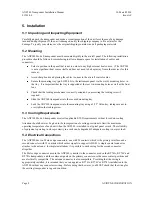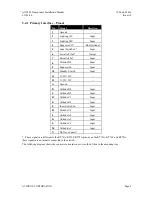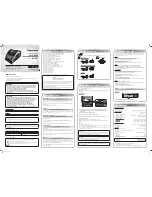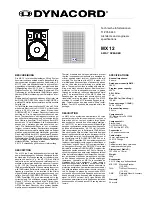
AXP340 Transponder Installation Manual
10 March 2014
01201-00
Issue AF
Page 22
AVIDYNE CORPORATION
based on the certification standard that was used by the GPS vendor. This will be indicated in the form of a
letter code (A to D) on the data plate or installation documentation for the GPS in accordance with the
standards DO-178B and DO-254, for example “DO-178B level C”. If both standards are reported but at
different levels, use the lower standard (higher letter).
6.1.10
GPS NACv
Another metric that the ADS-B ground system uses to help it track the aircraft is NACv. NACv is the
Navigational Accuracy Category for velocity, and is a design feature of the GPS receiver. It represents the
error bound for velocity that the GPS may report in acceleration/deceleration or turning manoeuvres. You
can find this information from your GPS installation manual.
6.1.11
Aircraft Length and Width
On the ground, ADS-B transmits encoded aircraft size information which is used by ATC to identify taxiing
routes and potential conflicts. When configured for ADS-B, the AXP340 will ask for the aircraft length and
width (wingspan), in metres, and will calculate the appropriate size code for transmission.
6.1.12
GPS Antenna Offset
The GPS antenna offset is used together with the aircraft length and width to manage taxiway conflicts. A
typical GPS installation does not report the geographic position of the centre of the aircraft, or even the tip
of the nose of the aircraft; instead it usually reports the location of the actual GPS antenna (not the GPS
receiver). In normal flight operations this distinction is of no practical importance at all, but if ADS-B is
used to manage taxiway conflicts, a significant offset in antenna position could mean that the aircraft is not
in the same place as the ADS-B reported position. Although primarily intended for position correction on
large transport aircraft, General Aviation aircraft can also have a significant offset. For example, if the
aircraft has a long tail boom and the GPS antenna is on the top of the tail, the GPS position could be 15 feet
or more from the nose of the aircraft.
Enter the position of the GPS antenna relative to the nose of the aircraft. The position is stored and
transmitted to the nearest 2 metres; great accuracy in measurement is not required.
6.1.13
ADS-B Receiver Options
In the USA there are two ADS-B channels, 1090ES and UAT, and there is an ADS-B based traffic
information service called TIS-B. The ADS-B ground stations relay this information between the two
channels so that suitably equipped aircraft can receive traffic information. To limit channel congestion
these services are only provided to aircraft equipped to receive them.
The transponder reports what receivers are installed in a periodic status message; enter the receiver status
here.
6.1.14
Audio Volume
The altitude alert function includes an audio alert. This configuration item lets you adjust the audio volume
output from the transponder using the selector knob. Whilst you are turning the volume control, the
transponder will periodically output a test signal to verify the settings.
Press the selector knob to accept and move to the next menu item.
6.1.15
Pressure Altitude Units
This configuration setting lets you select the units of the pressure altitude displayed on some transponder
















































